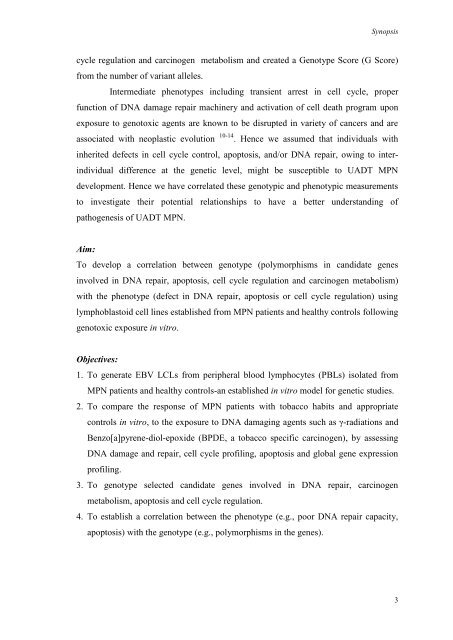LIFE09200604007 Tabish - Homi Bhabha National Institute
LIFE09200604007 Tabish - Homi Bhabha National Institute
LIFE09200604007 Tabish - Homi Bhabha National Institute
You also want an ePaper? Increase the reach of your titles
YUMPU automatically turns print PDFs into web optimized ePapers that Google loves.
Synopsis<br />
cycle regulation and carcinogen metabolism and created a Genotype Score (G Score)<br />
from the number of variant alleles.<br />
Intermediate phenotypes including transient arrest in cell cycle, proper<br />
function of DNA damage repair machinery and activation of cell death program upon<br />
exposure to genotoxic agents are known to be disrupted in variety of cancers and are<br />
associated with neoplastic evolution 10-14 . Hence we assumed that individuals with<br />
inherited defects in cell cycle control, apoptosis, and/or DNA repair, owing to interindividual<br />
difference at the genetic level, might be susceptible to UADT MPN<br />
development. Hence we have correlated these genotypic and phenotypic measurements<br />
to investigate their potential relationships to have a better understanding of<br />
pathogenesis of UADT MPN.<br />
Aim:<br />
To develop a correlation between genotype (polymorphisms in candidate genes<br />
involved in DNA repair, apoptosis, cell cycle regulation and carcinogen metabolism)<br />
with the phenotype (defect in DNA repair, apoptosis or cell cycle regulation) using<br />
lymphoblastoid cell lines established from MPN patients and healthy controls following<br />
genotoxic exposure in vitro.<br />
Objectives:<br />
1. To generate EBV LCLs from peripheral blood lymphocytes (PBLs) isolated from<br />
MPN patients and healthy controls-an established in vitro model for genetic studies.<br />
2. To compare the response of MPN patients with tobacco habits and appropriate<br />
controls in vitro, to the exposure to DNA damaging agents such as γ-radiations and<br />
Benzo[a]pyrene-diol-epoxide (BPDE, a tobacco specific carcinogen), by assessing<br />
DNA damage and repair, cell cycle profiling, apoptosis and global gene expression<br />
profiling.<br />
3. To genotype selected candidate genes involved in DNA repair, carcinogen<br />
metabolism, apoptosis and cell cycle regulation.<br />
4. To establish a correlation between the phenotype (e.g., poor DNA repair capacity,<br />
apoptosis) with the genotype (e.g., polymorphisms in the genes).<br />
3

















